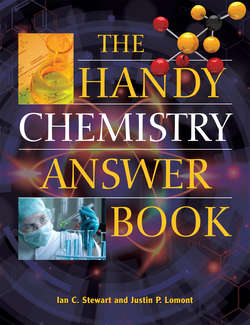Читать книгу The Handy Chemistry Answer Book - Justin P. Lomont - Страница 23
KINETICS AND THERMODYNAMICS
ОглавлениеWhat is a chemical reaction?
A chemical reaction is any process that involves the transformation of one or more molecules into one or more molecules—most of the time the reactant(s) and product(s) will be different molecules. A chemical reaction almost always involves the breaking and/or formation of new chemical bonds.
How do we write an equation for a chemical reaction?
Chemists often write “equations” to describe chemical reactions. It is conventional to list the initial species, or reactants, on the left side of the equation, followed by an arrow, and the final species, or products, on the right side of the equation. The equation below shows the reaction of methane and oxygen to produce water and carbon dioxide.
CH4 + 2 O2 CO2 + 2H2O
The arrow to the right indicates that the reactant species are converted to the product species during the course of the reaction. In some cases, reactions are reversible, which will be represented by two arrows, one pointing in either direction (). Be careful, because in chemistry is not the same as !
What is the yield for a reaction?
The yield of a chemical reaction is the amount of product that is produced (an example might be two grams). It is often of greater interest to consider the percent yield, which describes the amount of product formed relative to the maximum amount of product one could have expected based on the quantities of reactants used. The percent yield provides a measure of how efficient a process is for producing the target product.
What does selectivity mean for chemical reactions?
Selectivity can have several meanings for chemical reactions, but there are two main categories: either a reaction will occur selectively with a particular chemical species or at a particular location in a molecule to avoid unwanted side-reactions, or a reaction will produce a particular product selectively.
How do modern chemists characterize the products of chemical reactions?
Chemists need to characterize the products of their chemical reactions so that they can be sure of the structure and composition of the molecule(s) they have made. One common way is by measuring the melting point of a solid substance. This doesn’t provide specific information about the arrangement of chemical bonds in a molecule, though, so more advanced techniques are required to completely characterize a molecule. These techniques often involve using electromagnetic radiation to probe the energy levels in the molecules (see “Physical and Theoretical Chemistry” for more on these topics). Knowledge of what energies/wavelengths of light the molecule can absorb can be related directly to structural features of the molecule.
Are chemists still looking for new reactions?
Yes. Chemistry has hundreds of years of knowledge to build on, but it is in no way a complete field. New ways of making existing molecules, and making chemical structures that are completely new to our planet, are absolutely goals of modern chemistry. Developing new chemical reactions, and understanding old ones, are topics of eternal interest to chemists.
What is the law of conservation of matter?
The law of conservation of matter states that matter cannot be created or destroyed. This is relevant to chemical reactions because it tells us that we must have just as many atoms of each element at the beginning of a reaction as we do at the end of a reaction. In the example above, this is reflected by the fact that we use two molecules of oxygen, or four oxygen atoms from our reactants, to produce one molecule of CO2 and two molecules of H2O for a total of four oxygen atoms in our products.
What is the stoichiometry of a reaction?
The stoichiometry of a reaction is closely tied to the idea of the conservation of matter; it tells us the ratio in which the molecules react. Again using the example at the beginning of this chapter, the reaction stoichiometry 1:2:1:2 describes the ratio in which methane and oxygen react to form carbon dioxide and water.
Why do some chemical reactions cause a color change?
The colors we see all have to do with what wavelengths of light something absorbs or reflects. For a chemical reaction to cause a change in the color of something, all that has to happen is that the products of the reaction absorb and reflect different wavelengths of light than the reactants do. We’ll discuss how light interacts with molecules in more detail in “Physical and Theoretical Chemistry.”
